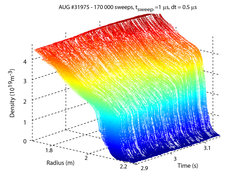Top grade for turbulence research
Virtual institute for Advanced Microwave Diagnostics for Plasma Dynamic and Turbulence Studies / Helmholtz Association’s evaluation passed

Turbulence and structurisation in plasma that can be investigated by means of microwaves are the subjects of research at a Virtual Institute which was established by several fusion laboratories and universities in 2012, headed by IPP and funded by the Helmholtz Association of German Research Centres. The evaluation by the Helmholtz Association, due after three years, has now been awarded the best grade A. The Virtual Institute was certified as an internationally outstanding proficiency centre for microwave technology and its application in plasma physics, whose funding will now continue for about three years.
Turbulence plays a major role in fusion plasmas. Little eddies are here the cause of perturbing energy and particle losses from plasma. They indirectly govern the size and thus the cost of a future fusion power plant. But as a universal natural phenomenon turbulence likewise influences the behaviour of cosmic plasmas. Turbulence simulation programmes from fusion research can be applied to other fields and, for example, also answer astrophysical questions. “Similar synergies are also being made useful on the esperimental side” states Professor Dr. Ulrich Stroth of IPP, who represents the Virtual Institute externally as spokesman. Newly developed microwave measuring methods are being applied to determine turbulence phenomena in general and those in fusion plasmas in particular. Scattered, reflected, emitted or used as radar, the microwaves yield information on plasma eddies and flows.
The innovative diagnostics are being planned and built on the division-of-labour principle and then tested and applied in the fusion devices of the Virtual Institute, viz. ASDEX Upgrade at Garching, TCV at Lausanne, and Tore Supra at Cadarache. Here is one example from ASDEX Upgrade: The figure shows how the profile of the plasma density changes during the decisive 0.25 seconds in which the magnetic confinement of the plasma jumps from poor to good thermal insulation. This transition from the low- to high-confinement regime, this being the plasma state envisaged for a power plant, is manifested in a steepening of the density profile at the plasma edge. This was measured at world record speed with an ultrafast microwave reflectometer from France's CEA, which is being operated on ASDEX Upgrade by a joint CEA-IPP PhD candidate.
